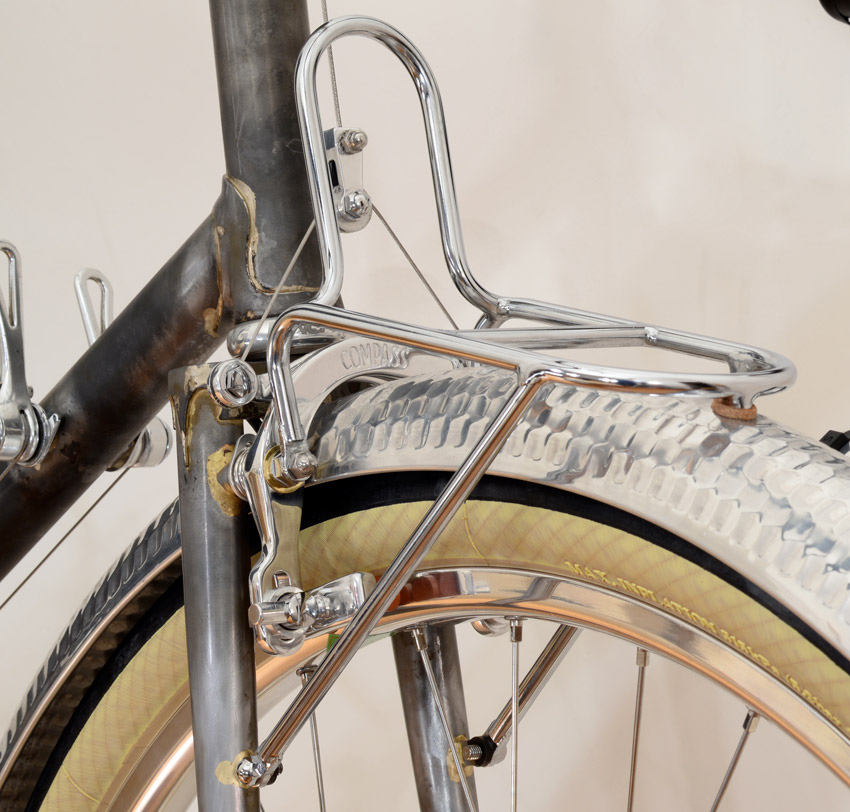Compass Centerpull Brakes Are Here!

We received the last parts for our centerpull brakes, test-assembled them, wrote the instructions, and now they are ready to ship.
Click here to read more about the advantage of centerpull brakes.
There are a lot of parts to a centerpull brake. It all starts with the braze-on posts that mounts onto the fork and seatstays. The holder for the spring is a ring that slides onto the post. It gets brazed in place when the builder brazes the posts onto the frame/fork. The builder can rotate the rings inward or outward to get more or less spring tension. (In practice, the standard setting, with the holes directly above the bosses, works great for most riders and with most brake levers.)

The posts are available in three models:
- Front (top): mitered to fit the Kaisei “Toei Special” fork blades without any additional filing. Of course, they can be mitered to fit most other fork blades.
- Rear (middle): with an offset miter that works well for most frame sizes.
- Universal (bottom): un-mitered bosses for any situation where the pre-mitered bosses don’t fit.
The brake arms are forged for the ultimate in strength and light weight, instead of machined. We analyzed many different shapes, and found that the classic Mafac Raid model optimizes strength and weight, while providing the optimum leverage to work with a multitude of brake levers. So we started with that shape and subtly optimized it for the added grip of modern brake pads. (You can use classic brake levers as well as modern STI/Ergo/DoubleTap lever with these brakes.)
The springs are custom, too. We tested stainless steel springs, but found that their rate changed over time, so ours are chrome-plated spring steel. That way, your brakes will retain their consistent performance for decades.
We made custom brake pad holders, which are a bit shorter than most modern pads. This allows them to clear the fork and seatstays when you open the brake, so that even fully inflated 42 mm-wide tires can pass through. The pads are Kool-Stop’s salmon-colored pads. These old-style pads are thicker than modern ones, which means they’ll last a lot longer. Of course, they use the best modern compound for the ultimate in brake power, both in wet and dry conditions.

Even the bolts are custom-made. (The only off-the-shelf parts are the silver washers on the left and the straddle cables.) Using custom bolts not only allows us to have smaller (and lighter) bolts, but the brake arms themselves are smaller and lighter, too.

The straddle cable attachment consists of four custom pieces. At one end (right in the photo above) there is the “dumbbell”, which acts as a quick release. (You unhook it from the brake arm to open the brake.)
On the other side (left), there is an eyebolt with a spacer and a special nut. The advantage of this system is that the two anchor points of the straddle wire can swivel as the straddle cable angle changes when you apply the brake. This eliminates the stress that tends to break straddle cables. It allows the use of a thinner shift lever cable as a straddle cable. The thinner cable can make a tighter bend at the cable hanger, so it doesn’t have as much springiness that translates into lost travel when you apply the brake.
Using a standard shifter cable as the straddle cable also means that if you ever need to replace the straddle cable, it’s easy to find a replacement. And you can set the straddle cable height where you want it – here it is set high so the hanger does not obstruct the taillight. (Centerpull brakes are not very sensitive to straddle cable length, unlike some cantilevers.)
Many will recognize these design features from classic Mafac centerpull brakes. We tried to improve on them, but with a few exceptions, we couldn’t – those mid-century French engineers knew what they were doing! Using tried-and-true technology not only means that we don’t need to worry about parts breaking, but also that our hardware fits on classic Mafac brakes.
If you have an old Mafac brakeset, you can use the new Compass hardware to replace everything but the arms, which shouldn’t wear out… If you want a brake for narrower 700C tires, a set of Mafac “Racer” arms and our hardware will get you a brake that is as good as new.

We didn’t like the stamped aluminum Mafac straddle cable hangers, so our brakes instead come with a replica of the lovely René Herse straddle cable hangers. These are reversible, so you can either set them that the roller spins freely, and equalizes the brake force of the two arms, or, if you have problems with one pad rubbing, you can set it so that the roller is fixed.

Together with the brakes, we offer a rack that is custom-designed to offer the same clearance as the brake. The rack is patterned after those made by René Herse. It is a clever piece of design that eliminates most of the stress risers where racks can break. Made by Nitto to our specifications, it’s also very light and elegant. We added a light mount, so that modern headlights (Edelux, IQ Cyo, etc.) can be mounted directly.

The rack attaches to the brake posts with special René Herse bolts, as well as to braze-ons on the fork. (Unfortunately, that means it isn’t an easy retrofit.)
We feel that by combining the genius and expertise of René Herse, Mafac and Nitto, we have created one of the very best brake/rack system for bikes with wide tires.
Click here for more information on the brakes, and here for information on the rack.


